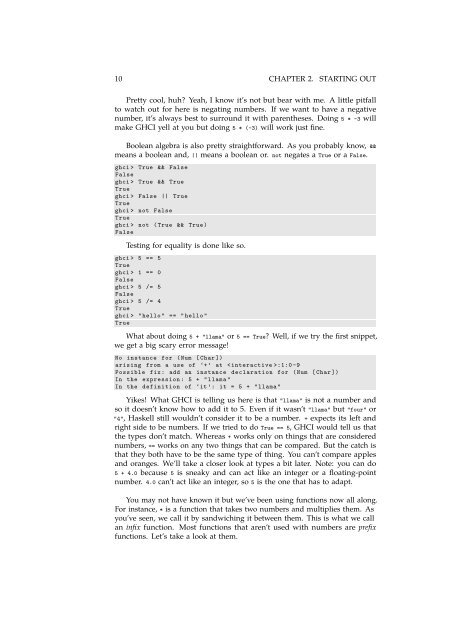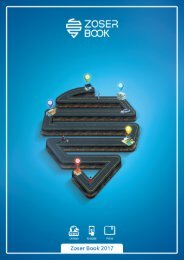Create successful ePaper yourself
Turn your PDF publications into a flip-book with our unique Google optimized e-Paper software.
10 CHAPTER 2. STARTING OUT<br />
Pretty cool, huh? Yeah, I know it’s not but bear with me. A little pitfall<br />
to watch out for here is negating numbers. If we want to have a negative<br />
number, it’s always best to surround it with parentheses. Doing 5 * -3 will<br />
make GHCI yell at you but doing 5 * (-3) will work just fine.<br />
Boolean algebra is also pretty straightforward. As you probably know, &&<br />
means a boolean and, || means a boolean or. not negates a True or a False.<br />
ghci > True && False<br />
False<br />
ghci > True && True<br />
True<br />
ghci > False || True<br />
True<br />
ghci > not False<br />
True<br />
ghci > not ( True && True )<br />
False<br />
Testing for equality is done like so.<br />
ghci > 5 == 5<br />
True<br />
ghci > 1 == 0<br />
False<br />
ghci > 5 /= 5<br />
False<br />
ghci > 5 /= 4<br />
True<br />
ghci > " hello " == " hello "<br />
True<br />
What about doing 5 + "llama" or 5 == True? Well, if we try the first snippet,<br />
we get a big scary error message!<br />
No instance for ( Num [ Char ])<br />
arising from a use of ‘+’ at < interactive >:1:0 -9<br />
Possible fix : add an instance declaration for ( Num [ Char ])<br />
In the expression : 5 + " llama "<br />
In the definition of ‘it ’: it = 5 + " llama "<br />
Yikes! What GHCI is telling us here is that "llama" is not a number and<br />
so it doesn’t know how to add it to 5. Even if it wasn’t "llama" but "four" or<br />
"4", Haskell still wouldn’t consider it to be a number. + expects its left and<br />
right side to be numbers. If we tried to do True == 5, GHCI would tell us that<br />
the types don’t match. Whereas + works only on things that are considered<br />
numbers, == works on any two things that can be compared. But the catch is<br />
that they both have to be the same type of thing. You can’t compare apples<br />
and oranges. We’ll take a closer look at types a bit later. Note: you can do<br />
5 + 4.0 because 5 is sneaky and can act like an integer or a floating-point<br />
number. 4.0 can’t act like an integer, so 5 is the one that has to adapt.<br />
You may not have known it but we’ve been using functions now all along.<br />
For instance, * is a function that takes two numbers and multiplies them. As<br />
you’ve seen, we call it by sandwiching it between them. This is what we call<br />
an infix function. Most functions that aren’t used with numbers are prefix<br />
functions. Let’s take a look at them.



